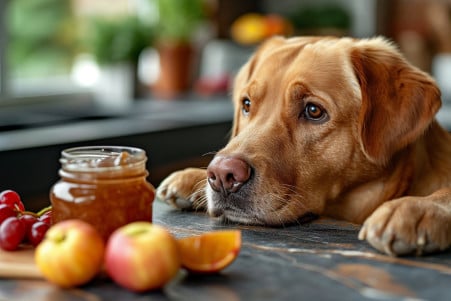Can Dogs Have Jelly Beans? Know the Risks
2 March 2024 • Updated 2 March 2024

While jelly beans are a delicious snack for humans, they are not safe for dogs. Dogs cannot have jelly beans. Jelly beans are made with sugar, xylitol, caffeine, and other ingredients that are poisonous to dogs, and can cause serious health problems like hypoglycemia and liver damage. It’s important to make sure your dog does not have access to jelly beans.
By looking at veterinary knowledge and nutritional science, we can learn why jelly beans and other similar treats are bad for our dogs. This article will go over the dangers of certain sweeteners, the ways that dogs and humans process food differently, and what makes a healthy diet for dogs, to give a complete picture of what you should and should not feed your dog.
The goal of this article is to help dog owners understand how to make sure their pets are safe and healthy, and avoid common feeding pitfalls.
Can dogs have jelly beans?
The Dangers of Sugar: Jelly Beans and Dogs
While jelly beans are a sweet treat for humans, they are a danger to dogs. In addition to the high sugar content that can lead to obesity and diabetes in dogs, jelly beans often contain artificial sweeteners, which are even more problematic.
One artificial sweetener, xylitol, is commonly found in sugar-free jelly beans and can be toxic to dogs. According to the FDA, xylitol can cause a rapid and severe drop in a dog’s blood sugar, leading to symptoms like vomiting, lethargy, lack of coordination, seizures, and in some cases, liver failure.
If you think your dog has ingested xylitol, it’s important to get them to a vet right away. Even a small amount of xylitol can be fatal, so it’s important to get treatment as soon as possible.
Spoiled Hounds warns dog owners to read labels carefully and make sure that any sweets, especially those that contain xylitol, are stored where dogs can’t get to them. By being careful about the treats we give our dogs, we can make sure they don’t end up eating something that could be dangerous to them.
Caffeine: A Lesser-Known Danger in Flavored Jelly Beans
In addition to being a go-to stimulant for people, caffeine is also a toxic substance for dogs, especially when it is hidden in flavored jelly beans. Some jelly bean flavors, especially those that are coffee- or chocolate-flavored, may contain caffeine, which is chemically related to theobromine, the substance in chocolate that is toxic to dogs (Hepper).
The signs of caffeine toxicity in dogs are similar to those of chocolate toxicity and can include hyperactivity, panting, increased heart rate, and seizures.
The long-term effects of caffeine consumption can be even more serious. If a dog has consumed jelly beans that contain caffeine, it is important to get them to a vet as soon as possible because symptoms can appear within a few hours.
The vet may take steps to immediately address the situation, including inducing vomiting to prevent the continued absorption of the toxic substance. Pet owners need to make sure they are taking the right steps to keep all forms of caffeine, including certain jelly beans, out of their pets’ reach to prevent these potentially life-threatening situations.
Understanding the dangers of caffeine toxicity in dogs is a reminder of the importance of understanding their specific nutritional needs. Being a good pet owner means not only avoiding dangerous treats but also making sure that your pet is getting a diet that meets their specific metabolic needs.
Doggy Diet: How to Feed Your Pup
Dogs have very different nutritional needs than humans, and those needs are based on their evolution as omnivores. While dogs have evolved to eat the cooked food that their human companions eat, they still have specific nutritional needs. They need a diet that includes proteins, fats, carbohydrates, vitamins, and minerals in order to stay healthy and strong.
Feeding your dog human food like jelly beans can throw off this balance and be harmful because dogs metabolize things differently, which can lead to health problems.
In order to keep your dog healthy and free from disease, it’s important to stick to a diet that’s formulated specifically for dogs. A balanced diet for dogs, according to PetMD, will meet their energy needs, which will depend on their age, activity level, and breed. Dogs will do best with whole-food ingredients that are real and recognizable, not processed foods that are full of sugar and artificial flavors.
There are healthier, dog-friendly alternatives for dog owners who want to treat their furry friends. For example, dog treats are often lower in calories and have added nutrients that are good for dogs’ unique metabolisms. By choosing these options, dog owners can make sure that their dogs are getting the nutrition they need to stay healthy and strong.
What to Do and Veterinary Treatment for Jelly Bean Poisoning
If your dog has eaten jelly beans, you must act quickly. First, try to figure out how many jelly beans your dog ate and what they contained, especially if they had xylitol or caffeine in them. According to the Merck Veterinary Manual, xylitol can cause severe hypoglycemia and liver damage. It is also important not to induce vomiting unless directed by a veterinarian, as it can cause more harm than good.
When you call the vet, they may tell you to bring your dog in for immediate treatment. As the American Kennel Club explains, this treatment may include decontamination and supportive care, such as intravenous dextrose, to treat hypoglycemia. A study in PMC backs up this treatment, showing that a dog that ingested a large amount of xylitol was successfully treated using these methods.
It is important to get your dog to the vet as soon as possible, as even a short delay can lead to more severe symptoms or complications.
When you talk to the vet, be sure to give them as much information as possible about what your dog ate and how much they ate. This will help them give your dog the treatment they need to save their life.
In the end, when it comes to jelly bean poisoning, the faster you can act and the more information you can give the vet, the better the chance your dog has for a full recovery.
Healthy Treat Options for Your Dog
Thankfully, there are plenty of dog-friendly options for treating your pup that are not only safe but healthy. Raleigh Vet suggests adding fruits and vegetables like apples (without the seeds), green beans, carrots, and blueberries to your dog’s diet as low-calorie, nutrient-dense options that are safe. As Dr. Patty Khuly explains, these treats can help with weight management and have other health benefits.
Of course, it’s important to give treats in moderation to ensure that your dog’s diet stays balanced and to avoid overfeeding. Pawsitively Pure Dog Food recommends that treats make up no more than 10% of a dog’s daily caloric intake. When you’re trying out new treats, introduce them slowly to make sure your dog doesn’t have a bad reaction to them and make sure they don’t contain any toxic ingredients.
When choosing treats for your pet, make sure to read labels carefully. Healthy options are those that don’t contain any fillers or artificial ingredients and that provide whole-food nutrition.
Whether it’s a fresh, crunchy carrot or a slice of apple, these treats can be a fun way to spoil your pet in a safe and healthy manner. After all, the best treats are those that are not only delicious but that also have a positive impact on your dog’s health.
Final Thoughts on Canine Confections: Why Jelly Beans Are a No-Go for Dogs
Between the sugar, artificial sweeteners, and potential caffeine, jelly beans are a recipe for disaster when it comes to your dog’s health. Not only are these sugary treats inappropriate for dogs, but they can also be downright dangerous, leading to issues like hypoglycemia, obesity, diabetes, and even liver damage. This makes it especially important to understand the importance of a diet that’s tailored to your dog’s unique needs and metabolism.
Pet parents need to make sure they’re doing everything they can to prevent their pets from accidentally eating things that could be toxic to them. This means staying informed and aware of the risks so that you can avoid a potentially dangerous situation. Luckily, there are plenty of dog treats that are safe and healthy for your pet and offer nutritional benefits without the risks that come with human treats.
In the end, it’s important to remember that your dog’s health is largely in your hands, especially when it comes to the food and treats you give them. By choosing dog-friendly treats and being mindful of their specific dietary needs, you can rest easy knowing that you’re doing your part to support a happy, healthy, and well-fed pet.


